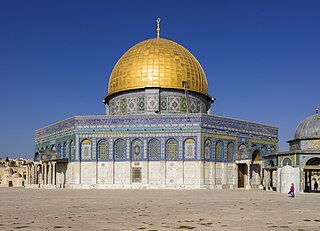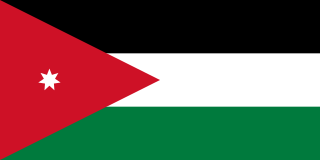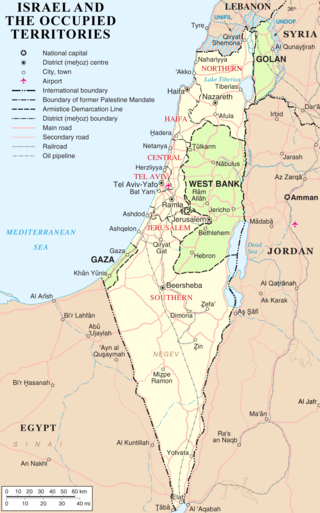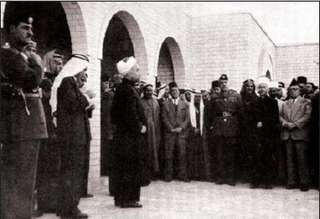International recognition
| Country | Date |
|---|---|
| 12 October 1948 | |
| 12 October 1948 | |
| 1948 | |
| 1948 | |
| ? |
The 1948 Palestinian declaration of independence was proclaimed by the Palestinian National Council convened in Gaza City on 1 October 1948. The declaration was recognized by Arab countries. The Arab League encouraged its member states to recognize the Palestinian government in Gaza. This was the first occasion that the Palestinians took the initiative to achieve national independence. Due to the conflicting interests of Arab nations, particularly between the Kingdom of Egypt and the Kingdom of Jordan under Abdullah I, who sought to incorporate sections of Palestine, the government quickly deteriorated, resulting in the declaration of independence becoming ineffective.
After 1948, the Palestinians became more dependent on Arab countries than ever before. Only in 1964 was a political entity (PLO) established that enjoyed relative independence.
The government also approved the flag of the new state to be the flag of the Arab Revolt of 1916. [1]
| Country | Date |
|---|---|
| 12 October 1948 | |
| 12 October 1948 | |
| 1948 | |
| 1948 | |
| ? |
The United States Government considers the establishment of a “Palestinian Arab Government” under current circumstances to be unjust to a successful solution to the Palestinian problem as well as to the best interests of the Arab countries and the Arab residents of Palestine.
In response to the Palestinian National Council, Abdullah I held a Palestinian counter-conference in Jericho on December 1, 1948. The conference adopted a resolution to unequivocally support unity between the two banks of Jordan. [2]
On January 27, 1949, the Ministry of Foreign Affairs of the All-Palestine Government sent a memorandum to the General Secretariat of the League expressing its protest about the League's failure to adhere to its promise “to provide financial support in order to enable the government to perform its duties.”
As a sign of recognition, Hilmi Abdel Baqi, in his capacity as Prime Minister of the All-Palestine Government, participated in the tenth session of the League Council held in Cairo on March 17–21, 1949. However, the Arab League later refrained from inviting Ahmed Hilmi to attend the eleventh session between October 17, 1949, and February 15, 1950, mainly due to opposition to Abdullah's government in Jordan. [2] In a memorandum sent to the General Secretariat, the Palestinian Ministry of Foreign Affairs expressed its strong protest against not being invited to the League session. During 1951, the All-Palestinian Government continued to decline, as most or all of its members stepped down or found positions in Arab countries.

The history of the State of Palestine describes the creation and evolution of the State of Palestine in the West Bank and Gaza Strip. During the British mandate period, numerous plans of partition of Palestine were proposed but without the agreement of all parties. In 1947, the United Nations Partition Plan for Palestine was voted for. The leaders of the Jewish Agency for Palestine accepted parts of the plan, while Arab leaders refused it. This triggered the 1947–1949 Palestine war and led, in 1948, to the establishment of the state of Israel on a part of Mandate Palestine as the Mandate came to an end.
Palestinian refugees are citizens of Mandatory Palestine, and their descendants, who fled or were expelled from their country over the course of the 1948 Palestine war and during the 1967 Six-Day War. Most Palestinian refugees live in or near 68 Palestinian refugee camps across Jordan, Lebanon, Syria, the West Bank and the Gaza Strip. In 2019 more than 5.6 million Palestinian refugees were registered with the United Nations.

The Palestinian territories, also known as the Occupied Palestinian Territory, consist of the West Bank and the Gaza Strip—two regions of the former British Mandate for Palestine that have been occupied by Israel since the Six-Day War of 1967. These territories make up the State of Palestine, which was self-declared by the Palestine Liberation Organization in 1988 and is recognized by 145 out of 193 UN member states.

Palestine, officially the State of Palestine, is a country in the southern Levant region of West Asia recognized by 145 out of 193 UN member states. It encompasses the Israeli-occupied West Bank and Gaza Strip, collectively known as the Palestinian territories, within the broader geographic and historical Palestine region. The country shares most of its borders with Israel, and it borders Jordan to the east and Egypt to the southwest. It has a total land area of 6,020 square kilometres (2,320 sq mi) while its population exceeds five million people. Its proclaimed capital is Jerusalem, while Ramallah serves as its administrative center. Gaza City was its largest city until 2023.

The Jordanian administration of the West Bank officially began on April 24, 1950, and ended with the decision to sever ties on July 31, 1988. The period started during the 1948 Arab-Israeli War, when Jordan occupied and subsequently annexed the portion of Mandatory Palestine that became known as the West Bank, including East Jerusalem. The territory remained under Jordanian control until it was occupied by Israel during the 1967 Six Day War and eventually Jordan renounced its claim to the territory in 1988.

The 1949 Armistice Agreements, which ended the 1948 Arab–Israeli War by delineating the Green Line as the legal boundary between Israel and the Arab countries, left the Kingdom of Egypt in control of a small swath of territory that it had captured and occupied in the former British Mandate for Palestine: the Gaza Strip. This period saw the creation of the All-Palestine Government within the All-Palestine Protectorate, an Egyptian client state that lasted until 1959, a year after the Republic of Egypt and the Second Syrian Republic merged to form a single sovereign state known as the United Arab Republic. The Egyptian administration of the Gaza Strip was briefly subsumed by Israel during the 1956 Suez Crisis and ended entirely during the 1967 Arab–Israeli War, after which the territory became occupied by Israel with the establishment of the Israeli Military Governorate.
The Arab League was formed in Cairo on 22 March 1945 with six members: Egypt, Iraq, Transjordan, Lebanon, Saudi Arabia, and Syria. Yemen joined on 5 May 1945. Since its formation the Arab League has promoted the Palestinian Arab cause in the Israeli–Palestinian conflict, including by imposing the Arab League boycott of Israel. The Arab League opposed the United Nations Partition Plan for Palestine in 1947. On 15 May 1948, the then seven Arab League members coordinated an invasion of what was by then the former British Mandate, marking the start of the 1948 Arab–Israeli War.
The government of Palestine is the government of the Palestinian Authority or State of Palestine. The Executive Committee of the Palestine Liberation Organization (EC) is the highest executive body of the Palestine Liberation Organization and acts as the government. Since June 2007, there have been two separate administrations in Palestine, one in the West Bank and the other in the Gaza Strip. The government on the West Bank was generally recognised as the Palestinian Authority Government. On the other hand, the government in the Gaza Strip claimed to be the legitimate government of the Palestinian Authority. Until June 2014, when the Palestinian Unity Government was formed, the government in the West Bank was the Fatah-dominated Palestinian government of 2013. In the Gaza Strip, the government was the Hamas government of 2012. Following two Fatah–Hamas Agreements in 2014, on 25 September 2014 Hamas agreed to let the PA Government resume control over the Gaza Strip and its border crossings with Egypt and Israel, but that agreement had broken down by June 2015, after President Abbas said the PA government was unable to operate in the Gaza Strip.
The Arab–Israeli conflict began in the 20th century, evolving from earlier Intercommunal violence in Mandatory Palestine. The conflict became a major international issue with the birth of Israel in 1948. The Arab–Israeli conflict has resulted in at least five major wars and a number of minor conflicts. It has also been the source of two major Palestinian uprisings (intifadas).

The modern borders of Israel exist as the result both of past wars and of diplomatic agreements between the State of Israel and its neighbours, as well as an effect of the agreements among colonial powers ruling in the region before Israel's creation. Only two of Israel's five total potential land borders are internationally recognized and uncontested, while the other three remain disputed; the majority of its border disputes are rooted in territorial changes that came about as a result of the 1967 Arab–Israeli War, which saw Israel occupy large swathes of territory from its rivals. Israel's two formally recognized and confirmed borders exist with Egypt and Jordan since the 1979 Egypt–Israel peace treaty and the 1994 Israel–Jordan peace treaty, while its borders with Syria, Lebanon and the Palestinian territories remain internationally defined as contested.

The following outline is provided as an overview of and topical guide to the State of Palestine:
Israel–Jordan relations are the diplomatic, economic and cultural relations between Israel and Jordan. The two countries share a land border, with three border crossings: Yitzhak Rabin/Wadi Araba Crossing, Jordan River Crossing and the Allenby/King Hussein Bridge Crossing, that connects the West Bank with Jordan. The relationship between the two countries is regulated by the Israel–Jordan peace treaty in 1994, which formally ended the state of war that had existed between the two countries since the establishment of the State of Israel in 1948, and also established diplomatic relations, besides other matters. Relations between the countries get strained from time to time, usually over tensions at the Al-Aqsa mosque. On 8 October 2020, Israel and Jordan reached an agreement to allow flights to cross over both countries’ airspace.

The Jericho Conference was held in December 1948 to decide the future of the portion of Palestine that was held by Jordan at the end of the 1948 Arab–Israeli War, led by Sheikh Muhammad Ali Ja'abari. Pro-Jordanian personalities called for the annexation of the West Bank, including East Jerusalem, to Jordan.

The Palestinian Authority Passport is a passport/travel document issued since April 1995 by the Palestinian Authority to Palestinian residents of the Palestinian territories for the purpose of international travel.

Egypt–Palestine relations are the bilateral relations between the Arab Republic of Egypt and the State of Palestine. Egyptian President Gamal Abdel Nasser was a strong supporter of the Palestinian cause and he favored self-determination for the Palestinians. Although the Egyptian government has maintained a good relationship with Israel since the Camp David Accords, most Egyptians strongly resent Israel, and disapprove of the close relationship between the Israeli and Egyptian governments.

Ahmed Hilmi Abd al-Baqi Pasha was an Arab soldier, economist, and politician of Albanian descent, who served in various positions in post-Ottoman Levant, and later as Prime Minister of the short-lived All-Palestine Government in the Gaza Strip.

The Palestinian Declaration of Independence formally established the State of Palestine, and was written by Palestinian poet Mahmoud Darwish and proclaimed by Yasser Arafat on 15 November 1988 in Algiers, Algeria. It had previously been adopted by the Palestinian National Council (PNC), the legislative body of the Palestine Liberation Organization (PLO), by a vote of 253 in favour, 46 against, and 10 abstaining. It was read at the closing session of the 19th PNC to a standing ovation. Upon completing the reading of the declaration, Arafat, as Chairman of the PLO, assumed the title of President of Palestine. In April 1989, the PLO Central Council elected Arafat as the first President of the State of Palestine.

The All-Palestine Government was established on 22 September 1948, during the 1948 Arab–Israeli War, to govern the Egyptian-controlled territory in Gaza, which Egypt had on the same day declared as the All-Palestine Protectorate. It was confirmed by the Arab League and recognised by six of the then seven Arab League members, with Transjordan being the exception. Though it claimed jurisdiction over the whole of the former Mandatory Palestine, its effective jurisdiction was limited to the All-Palestine Protectorate, which came to be called the Gaza Strip. The President of the protectorate was Hajj Amin al-Husseini, former chairman of the Arab Higher Committee, and the Prime Minister was Ahmed Hilmi Pasha. The legislative body was the All-Palestine National Council.

The Arab Higher Committee or the Higher National Committee was the central political organ of Palestinian Arabs in Mandatory Palestine. It was established on 25 April 1936, on the initiative of Haj Amin al-Husayni, the Grand Mufti of Jerusalem, and comprised the leaders of Palestinian Arab clans and political parties under the mufti's chairmanship. The committee was outlawed by the British Mandatory administration in September 1937 after the assassination of a British official.

The All-Palestine Protectorate, also known as All-Palestine, the Gaza Protectorate or the Gaza Strip, was a short-lived client state with limited recognition, corresponding to the area of the modern Gaza Strip, that was established in the area captured by the Kingdom of Egypt during the 1948 Arab–Israeli War and allowed to run as a protectorate under the All-Palestine Government. The Protectorate was declared on 22 September 1948 in Gaza City, and the All-Palestine Government was formed. The President of the Gaza-seated administration was Hajj Amin al-Husseini, the former chairman of the Arab Higher Committee, while the Prime Minister was Ahmed Hilmi Pasha. In December 1948, just three months after the declaration, the All-Palestine Government was relocated to Cairo and was never allowed to return to Gaza, making it a government in exile. With a further resolution of the Arab League to put the Gaza Strip under the official protection of Egypt in 1952, the All-Palestine Government was gradually stripped of its authority. In 1953, the government was nominally dissolved, though the Palestinian Prime Minister, Hilmi Pasha, continued to attend Arab League meetings on its behalf. In 1959, the protectorate was de jure merged into the United Arab Republic, while de facto turning Gaza into a military occupation area of Egypt.